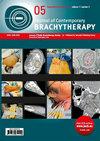Feasibility and clinical implementation of MRI-guided surface brachytherapy
IF 1.1
4区 医学
Q4 ONCOLOGY
引用次数: 0
Abstract
Purpose:Best practices for high-dose-rate surface applicator brachytherapy treatment (SABT) have long relied on computed tomography (CT)-based imaging to visualize diseased sites for treatment planning. Compared with magnetic resonance (MR)-based imaging, CT provides insufficient soft tissue contrast. This work described the feasibility of clinical implementation of MR-based imaging in SABT planning to provide individualized treatment optimization.
Material and methods:
A 3D-printed phantom was used to fit Freiberg flap-style (Elekta, The Netherlands) applicator. Images were taken using an optimized pointwise encoding time reduction with radial acquisition (PETRA) MR sequence for catheter visualization, and a helical CT scan to generate parallel treatment plans. This clinical study included three patients undergoing SABT for Dupuytren’s contracture/palmar fascial fibromatosis imaged with the same modalities. SABT planning was performed in Oncentra Brachy (Elekta Brachytherapy, The Netherlands) treatment planning software. A geometric analysis was conducted by comparing CT-based digitization with MR-based digitization. CT and MR dwell positions underwent a rigid registration, and average Euclidean distances between dwell positions were calculated. A dosimetric comparison was performed, including point-based dose difference calculations and volumetric segmentations with Dice similarity coefficient (DSC) calculations.
Results:
Euclidean distances between dwell positions from CT-based and MR-based plans were on average 0.68 ±0.05 mm and 1.35 ±0.17 mm for the phantom and patients, respectively. The point dose difference calculations were on average 0.92% for the phantom and 1.98% for the patients. The D95 and D90 DSC calculations were both 97.9% for the phantom, and on average 93.6% and 94.2%, respectively, for the patients.
Conclusions:
The sub-millimeter accuracy of dwell positions and high DSC’s (> 0.95) of the phantom demonstrated that digitization was clinically acceptable, and accurate treatment plans were produced using MR-only imaging. This novel approach, MRI-guided SABT, will lead to individualized prescriptions for potentially improved patient outcomes.
核磁共振成像引导下表面近距离放射治疗的可行性和临床应用
目的:长期以来,高剂量率表面涂敷近距离治疗(SABT)的最佳实践一直依赖于基于计算机断层扫描(CT)的成像来观察病变部位,以便制定治疗计划。与基于磁共振(MR)的成像相比,CT 提供的软组织对比度不足。这项工作描述了在 SABT 计划中临床实施基于 MR 的成像以提供个体化治疗优化的可行性。材料和方法:使用 3D 打印的模型来安装 Freiberg 瓣式(Elekta,荷兰)涂抹器。使用径向采集(PETRA)的优化点状编码时间缩短磁共振序列拍摄导管图像,并使用螺旋 CT 扫描生成平行治疗计划。这项临床研究包括三名接受 SABT 治疗的杜普伊特伦挛缩症/掌筋膜纤维瘤病患者,采用相同的模式进行成像。SABT 计划在 Oncentra Brachy(荷兰 Elekta Brachytherapy)治疗计划软件中进行。通过比较基于 CT 的数字化和基于 MR 的数字化,进行了几何分析。对 CT 和 MR 驻留位置进行了刚性配准,并计算了驻留位置之间的平均欧氏距离。结果:对于模型和患者,基于 CT 和基于 MR 计划的停留位置之间的欧氏距离平均分别为 0.68 ±0.05 毫米和 1.35 ±0.17 毫米。模型和患者的点剂量差计算结果分别为平均 0.92% 和 1.98%。模型的 D95 和 D90 DSC 计算结果均为 97.9%,患者的平均值分别为 93.6% 和 94.2%。结论:模型停留位置的亚毫米级精度和高 DSC(> 0.95)表明,数字化在临床上是可以接受的,而且只使用磁共振成像就能生成精确的治疗计划。MRI 引导下的 SABT 这种新方法将实现个性化处方,从而改善患者的治疗效果。
本文章由计算机程序翻译,如有差异,请以英文原文为准。
求助全文
约1分钟内获得全文
求助全文
来源期刊

Journal of Contemporary Brachytherapy
ONCOLOGY-RADIOLOGY, NUCLEAR MEDICINE & MEDICAL IMAGING
CiteScore
2.40
自引率
14.30%
发文量
54
审稿时长
16 weeks
期刊介绍:
The “Journal of Contemporary Brachytherapy” is an international and multidisciplinary journal that will publish papers of original research as well as reviews of articles. Main subjects of the journal include: clinical brachytherapy, combined modality treatment, advances in radiobiology, hyperthermia and tumour biology, as well as physical aspects relevant to brachytherapy, particularly in the field of imaging, dosimetry and radiation therapy planning. Original contributions will include experimental studies of combined modality treatment, tumor sensitization and normal tissue protection, molecular radiation biology, and clinical investigations of cancer treatment in brachytherapy. Another field of interest will be the educational part of the journal.
 求助内容:
求助内容: 应助结果提醒方式:
应助结果提醒方式:


